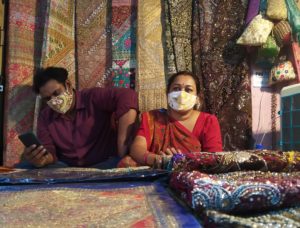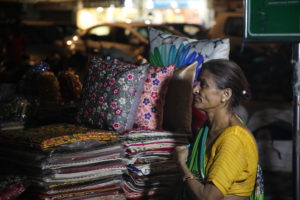Embroidery market frays amid the pandemic

Janpath market is popular for its high-quality embroidery at affordable prices (MIG Photos/Vinod Vikranth)
India is one of the biggest exporters of embroidered fabrics and garments in the world. From flea markets to shopping malls, one can see clothes, bags, curtains, covers and many other items laced in beautiful embroidery. However, due to Covid-19 pandemic this year, embroidery markets in the national capital Delhi are witnessing a loss like never before.
“I have been selling zari zardozi (a type of embroidery) clothes for the last 20 years in this market. Ordinarily, I would earn at least INR 10,000 a week, going up to INR 25,000 during the wedding and festive seasons. This is my only source of income and it used to be enough for my family. But things have changed ever since the pandemic started. People have stopped visiting markets. Even though markets reopened two months ago, I do not earn even half of what I used to. I don’t expect any kind of revival this year,” says Sheela, 40, an embroidered garments seller at the Janpath Market in New Delhi.
Waiting for customers even on a weekend, Sheela, along with her husband, sits idle in with colourful, embroidered garments all around her. They get embroidered fabrics from Gujrat and stitch sarees, skirts, tops, bags, pouches, wallets, curtains and cushion covers out of those. They say that they had already placed orders for fabrics and invested INR 40,000 in the third week of March, just before the series of ensuing lockdowns. With sales hitting rock bottom, the couple is facing a huge financial crisis.

Waiting for customers even on a weekend, Sheela, along with her husband, sits idle in with colourful, embroidered garments all around her (MIG Photos/Richa Nigam)
Ratan Singh, 45, another garment seller says that keeping his material locked up in the small, humid shop for over 3 months destroyed the goods, with a loss that could be as high as INR 50,000. “The lockdown was announced so suddenly that I didn’t get time to move my fabric stock to a safer place. I had to lock everything in a damp and dusty room nearby as I found no other place. I had fabrics worth INR 50,000 when the first lockdown was announced. Later, when markets opened, I unlocked the storeroom and saw that the fabric had lost its shine and had become dusty. I am in a bind as no one would buy a dirty garment and dry-cleaning the entire lot would cost a lot of money,’’ he says.
One of the largest embroidery markets in the capital, Janpath is home to hundreds of embroidery artisans whose livelihood depends solely on the visitors who buy their garments and fabrics. The market is popular for its high-quality embroidery at affordable prices. Many foreign tourists also visited the market frequently. Due to the imposition of sudden lockdowns in the country since March, the sale has dropped to almost zero as people fear the risk of catching Covid-19 infections. Even those who do visit the market, avoid buying from roadside shops like that of Sheela and Singh.
Sarita Devi, 70, has been doing embroidery using metal threads, since the past 35 years. She buys raw fabrics, stitches cushion covers and mats, does embroidery work on these and sells them in the market on the weekends. Devi, being an old woman who lives alone and had no other source of income, had to use her savings, amounting to only INR 3,000, to feed herself during the lockdown. She says that she did not get any assistance from the government as she did not have the right documents needed.

Sarita Devi, 70, has been doing embroidery using metal threads, for past 35 years (MIG Photos/Vinod Vikrath)
“I work for the whole week just so that I could earn some money on Saturdays and Sundays. As I work alone, every weekend I used to earn just enough for about the next 10 days every. Now that it has been almost two months since I resumed work, I am somehow managing to sustain. Earlier I used to earn at least INR 1,000-1,500 per week which has now reduced to barely INR 300-400,” Devi adds.
Embroidery work is an extended and time-consuming process which requires skilled craftsmen. Traders and sellers of embroidery work say that most skilled artisans in the embroidery industry in Delhi are migrants from Gujrat, Maharashtra and Odisha. Since the lockdown, most of them have gone back to their native states and are unlikely to return while the pandemic continues.
Pradeep Kumar sells embroidered garments a few metres away from Devi.“I had hired three artisans to help me do the intricate needlework on the fabrics. They went back home four months ago and haven’t returned. As I can’t find any other skilled person immediately, I have to manage everything on my own. My production has dropped and so has the sale. Metro service was the main source of conveyance to the market. I hope people visit the market and buy things when metro services resume,” Kumar says.









